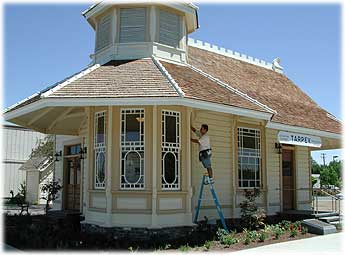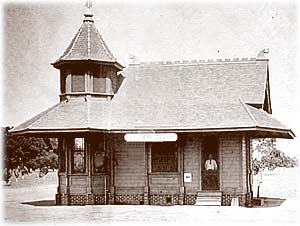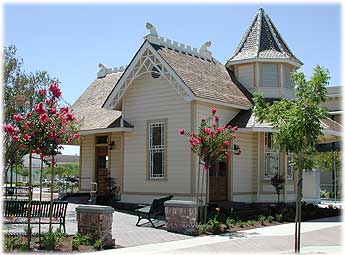 |
|
Volunteer, Bryan Hubbard of The Window Doctor
prepares Tarpey Station for a celebration barbecue to
honor the past and those who donated their services and time
in the Clovis Historical Society restoration project. [ Clovis
Free Press Photo]
|
OLD TOWN - It was in the Summer of 1891 and horse
drawn scrapers smoothed the way as men unloaded strong Cedar railroad
timber and carefully laid them on the ground near the corner of what
is now Clovis & 4th Streets.
Men and horses
were in a hurry to build a railway track between the Southern Pacific
Co. tracks in South Fresno and a rail-switch located near the
San Joaquin River a few miles North of the Clovis townsite. The
Southern Pacific Co. was under fire in Tulare County and was very
unpopular throughout Central California. A new private railroad seemed
like a good idea to most people in California.
A young 25 year old stranger who said his name was Clovis M.
Cole and who coincidentally had $160,000 in banknotes arrived here
and quickly bought up 40,0000 thousand acres of dry barren land. He
planted it mostly in wheat and waited. At about the same time another
stranger arrived on the scene. By fate or design the two newcomers
would soon be in league with each other.
The new man said his name was Marcus Pollasky and that he owned
a company that was starting up a venture called, The San Joaquin
Valley Railroad. He was looking for investors to purchase stock
in the venture that he said would cross the Sierra Nevada mountains
east of Clovis and supposedly connect with the High Sierra community
of Truckee.
 Local
residents were dubious but soon became excited about the prospect
of opening the area up to direct access to profitable business trade
with the East Coast. Many eagerly invested their life savings and
mortgaged their property to invest in Pollasky's company. As a show
of what he said was his good faith in Pollasky, Clovis Cole quickly
donated more than a thousand acres of right-of-way to Pollasky in
exchange for the construction of a three room depot to be constructed
adjacent to a townsite Cole had conveniently prepared in advance.
The Pollasky-Cole project impressed investors as far away as
Los Angeles and San Francisco. The timing was perfect and thousands
of investors bought into the project.
Local
residents were dubious but soon became excited about the prospect
of opening the area up to direct access to profitable business trade
with the East Coast. Many eagerly invested their life savings and
mortgaged their property to invest in Pollasky's company. As a show
of what he said was his good faith in Pollasky, Clovis Cole quickly
donated more than a thousand acres of right-of-way to Pollasky in
exchange for the construction of a three room depot to be constructed
adjacent to a townsite Cole had conveniently prepared in advance.
The Pollasky-Cole project impressed investors as far away as
Los Angeles and San Francisco. The timing was perfect and thousands
of investors bought into the project.
The new track was laid through Cole's Tarpey Ranch wheat fields,
vineyards, orchards, pastures, and over much barren ground. Here and
there all along the 26 mile route, carpenters would be building storage
sheds, loading platforms, and depot buildings that Cole and Pollasky
said were to accommodate the East Coast public who would ride the
train to the San Joaquin Valley to bring prosperity to Clovis Cole's
new town and profit to Pollasky's stock holders.
The Fresno
Republican Newspaper carried promotional coverage of opening
of the Tarpey Depot on Nov. 25, 1891 paid for by Pollasky,
"An invitation has been sent to all subscribers of the Guarantee
Fund, whether they are those who could and did give $5000 or those
who were able to give only a small portion of that amount." Over
3000 investors attended and were treated to a "free" ride
to the site of the celebration on a railroad flatcar. Pollasky and
his wife paid cash for a beautiful mansion house he had constructed
on Tulare Street in Fresno. It looked like the Pollasky's were going
to become leading citizens and his investors would be made suddenly
wealthy.
Appearances are
sometimes deceiving. Investors became curious as to why Pollasky's
railroad was using tools and equipment clearly marked with the name
and logo of the hated Southern Pacific Co.
Pollasky claimed he had rented the questionable
equipment from SP. By the following following year the picture was
becoming murkey.
Before Spring, the Pollasky's and the San Joaquin Valley Railroad
Co. were in Federal Bankruptcy Court in San Francisco where the
Court awarded the Southern Pacific Co. with a judgment against
Pollasky's railroad for $468,072. Worse yet, SP was then appointed
Receiver.
 By Summer the Court ordered an auction on the front steps of
the Fresno County Court house for June 13, 1893. The personal property,
all buildings, rights-of-way, track, and depot structures and the
San Joaquin Valley Railroad Franchise were sold to the one
and only bidder, the Southern Pacific Co. In a special
edition of The Fresno Republican Newspaper a report of the
sale listed assets as follows, "The franchise was sold for $50,
which was fully all that it was worth, considering the crookedness
of its line of track and pedigree. The personal property was sold
for $1,000 and the railroad and realty for $485,950....This closes
out this by-play at railroad building and dissipates all hopes of
reaching the timber belt by that route for some time to come."
Residents were never to see Pollasky nor their money again. Clovis
Cole died in 1939.
By Summer the Court ordered an auction on the front steps of
the Fresno County Court house for June 13, 1893. The personal property,
all buildings, rights-of-way, track, and depot structures and the
San Joaquin Valley Railroad Franchise were sold to the one
and only bidder, the Southern Pacific Co. In a special
edition of The Fresno Republican Newspaper a report of the
sale listed assets as follows, "The franchise was sold for $50,
which was fully all that it was worth, considering the crookedness
of its line of track and pedigree. The personal property was sold
for $1,000 and the railroad and realty for $485,950....This closes
out this by-play at railroad building and dissipates all hopes of
reaching the timber belt by that route for some time to come."
Residents were never to see Pollasky nor their money again. Clovis
Cole died in 1939.
[Editor's
Note: This week, the only remaining depot of three such buildings
has just been refurbished under the direction of the Clovis Historical
Society's Restoration Committee. The restored building located
at Clovis Ave. and 4th Streets will open for public inspection Tuesday
August. 1, 2000. The San Joaquin Valley Railroad began
construction on July 4, 1891 and ended near Friant on
January 20, 1892.
The railroad was built in part, it was said
at the time, to replace the Fresno Flume Irrigation Company's log
flume that was 42 miles long. It started at a site now under Shaver
Dam, elevation 5275 feet, and traveled 42 miles into the valley, dropping
4900 feet in elevation. The flume ended on the south side of Fifth
Street, east of Clovis Avenue.
This is now home to the Clovis Rodeo
Grounds and Clark Intermediate School. There was a need
for workers, and the town of Clovis began to grow around the
Clovis L umber Co. Barn adjacent to what is now the Clovis
Free Press Executive Office at 754 3rd. Street, Clovis.
The flume and lumber company shutdown in 1914, but Clovis kept
on growing.
For your free Historic
Railroad Screensaver or for more detailed information about the
organization and history of the San Joaquin Valley Railroad Company
from 2/5/1868 to 8/22/1870 -- See the historical Transcontinental
Railroad Early History mentioning the San Joaquin Valley
Railroad, published by of the U.S. Dept. of Interior in
1883. Also see a compact collection of old
railroad maps and The Library of Congress' collection of
early railroad
bibliographies.
Several embarrassing revelations in the late
nineteenth century provided powerful evidence for those who believed
that the Southern Pacific Railroad had corrupted local &
state politics. Two of the most notorious events focussed on the top
leaders of the SP company.
David Colton was the confidential manager
of the railroad's political interests in California. Following Colton's
death in 1878, his widow sued the Big Four for cheating her out of
part of her inheritance.
During the trial, she introduced hundreds
of letters & other documents signed by her late husband and railroad
officials. The letters laid bare the illegal conspiracies of railroad's
executives to influence elections, reelections, and votes of members
of the California Legislature.
Collis Huntington and Leland Stanford, became
involved in a public feud in the early 1890s. Huntington publicly
denounced Stanford for using large amounts of railroad money to secure
Stanford's election as a United States senator.
Stanford's private secretary later published
a series of letters that implicated Stanford in the wholesale corruption
of national, state, and local officials by the railroad.
There is also a comprehensive Directory
of Worldwide Railroad sites online! For an excellent series see
the Impact
of the Railroad Acts. ]




 Local
residents were dubious but soon became excited about the prospect
of opening the area up to direct access to profitable business trade
with the East Coast. Many eagerly invested their life savings and
mortgaged their property to invest in Pollasky's company. As a show
of what he said was his good faith in Pollasky, Clovis Cole quickly
donated more than a thousand acres of right-of-way to Pollasky in
exchange for the construction of a three room depot to be constructed
adjacent to a townsite Cole had conveniently prepared in advance.
The Pollasky-Cole project impressed investors as far away as
Los Angeles and San Francisco. The timing was perfect and thousands
of investors bought into the project.
Local
residents were dubious but soon became excited about the prospect
of opening the area up to direct access to profitable business trade
with the East Coast. Many eagerly invested their life savings and
mortgaged their property to invest in Pollasky's company. As a show
of what he said was his good faith in Pollasky, Clovis Cole quickly
donated more than a thousand acres of right-of-way to Pollasky in
exchange for the construction of a three room depot to be constructed
adjacent to a townsite Cole had conveniently prepared in advance.
The Pollasky-Cole project impressed investors as far away as
Los Angeles and San Francisco. The timing was perfect and thousands
of investors bought into the project. By Summer the Court ordered an auction on the front steps of
the Fresno County Court house for June 13, 1893. The personal property,
all buildings, rights-of-way, track, and depot structures and the
San Joaquin Valley Railroad Franchise were sold to the one
and only bidder, the Southern Pacific Co. In a special
edition of The Fresno Republican Newspaper a report of the
sale listed assets as follows, "The franchise was sold for $50,
which was fully all that it was worth, considering the crookedness
of its line of track and pedigree. The personal property was sold
for $1,000 and the railroad and realty for $485,950....This closes
out this by-play at railroad building and dissipates all hopes of
reaching the timber belt by that route for some time to come."
Residents were never to see Pollasky nor their money again. Clovis
Cole died in 1939.
By Summer the Court ordered an auction on the front steps of
the Fresno County Court house for June 13, 1893. The personal property,
all buildings, rights-of-way, track, and depot structures and the
San Joaquin Valley Railroad Franchise were sold to the one
and only bidder, the Southern Pacific Co. In a special
edition of The Fresno Republican Newspaper a report of the
sale listed assets as follows, "The franchise was sold for $50,
which was fully all that it was worth, considering the crookedness
of its line of track and pedigree. The personal property was sold
for $1,000 and the railroad and realty for $485,950....This closes
out this by-play at railroad building and dissipates all hopes of
reaching the timber belt by that route for some time to come."
Residents were never to see Pollasky nor their money again. Clovis
Cole died in 1939.